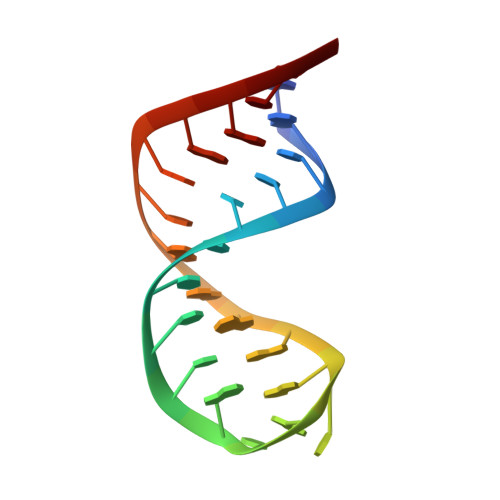Structure of the U6 RNA intramolecular stem-loop harboring an S(P)-phosphorothioate modification.
Reiter, N.J., Nikstad, L.J., Allman, A.M., Johnson, R.J., Butcher, S.E.(2003) RNA 9: 533-542
- PubMed: 12702812
- DOI: https://doi.org/10.1261/rna.2199103
- Primary Citation of Related Structures:
1NZ1, 1SY4 - PubMed Abstract:
Phosphorothioate-substitution experiments are often used to elucidate functionally important metal ion-binding sites on RNA. All previous experiments with S(P)-phosphorothioate-substituted RNAs have been done in the absence of structural information for this particular diastereomer. Yeast U6 RNA contains a metal ion-binding site that is essential for spliceosome function and includes the pro-S(P) oxygen 5' of U(80). S(P)-phosphorothioate substitution at this location creates spliceosomes dependent on thiophilic ions for the first step of splicing. We have determined the solution structure of the U(80) S(P)-phosphorothioate-substituted U6 intramolecular stem-loop (ISL), and also report the refined NMR structure of the unmodified U6 ISL. Both structures were determined with inclusion of (1)H-(13)C residual dipolar couplings. The precision of the structures with and without phosphorothioate (RMSD = 1.05 and 0.79 A, respectively) allows comparison of the local and long-range structural effect of the modification. We find that the U6-ISL structure is unperturbed by the phosphorothioate. Additionally, the thermodynamic stability of the U6 ISL is dependent on the protonation state of the A(79)-C(67) wobble pair and is not affected by the adjacent phosphorothioate. These results indicate that a single S(P)-phosphorothioate substitution can be structurally benign, and further validate the metal ion rescue experiments used to identify the essential metal-binding site(s) in the spliceosome.
Organizational Affiliation:
Department of Biochemistry, University of Wisconsin-Madison, Madison, Wisconsin 53706, USA.














